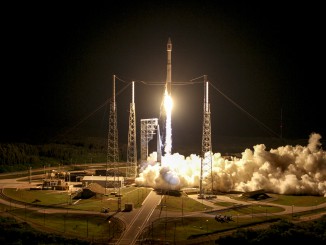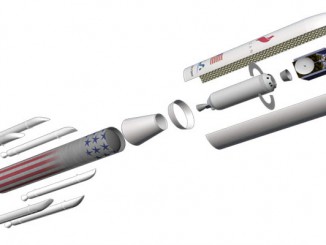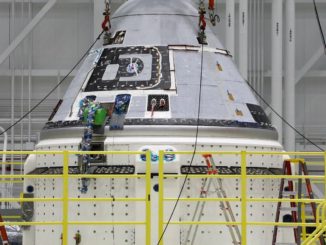
CAPE CANAVERAL — For the fifth time in four years, a massive U.S. Navy satellite will launch atop an Atlas 5 rocket on Friday to finish the military’s new $7.7 billion mobile communications framework 22,300 miles in space.
Liftoff of the United Launch Alliance rocket from Complex 41 at Cape Canaveral in Florida is scheduled during a 44-minute window stretching from 10:30 to 11:14 a.m. EDT (1430-1514 GMT).
The rocket will head eastward along an initial flight azimuth of 94.58 degrees.
It will mark the 645th launch for the Atlas program since 1957, the 350th Atlas launch from Cape Canaveral and the 211th Atlas-Centaur rocket.
Weather forecasters give an 80 percent chance of favorable conditions, saying that summertime thunderstorms shouldn’t fire up until after the launch window.
The MUOS satellite No. 5 will augment the globe-spanning constellation of Mobile User Objective System spacecraft as an in-orbit spare, joining four earlier craft launched by Atlas since 2012 that comprise the primary fleet.
“This launch is a significant event for the entire MUOS team because it will complete the five-satellite constellation. Not only will we have global coverage and further north and south towards the poles than ever before, but we also will have the assurance of an on-orbit spare,” said Navy Capt. Joe Kan, program manager for the Communications Satellite Program Office and MUOS program manager. “If anything should happen to one of the four satellites in orbit, we would be prepared to maintain coverage around the world.”
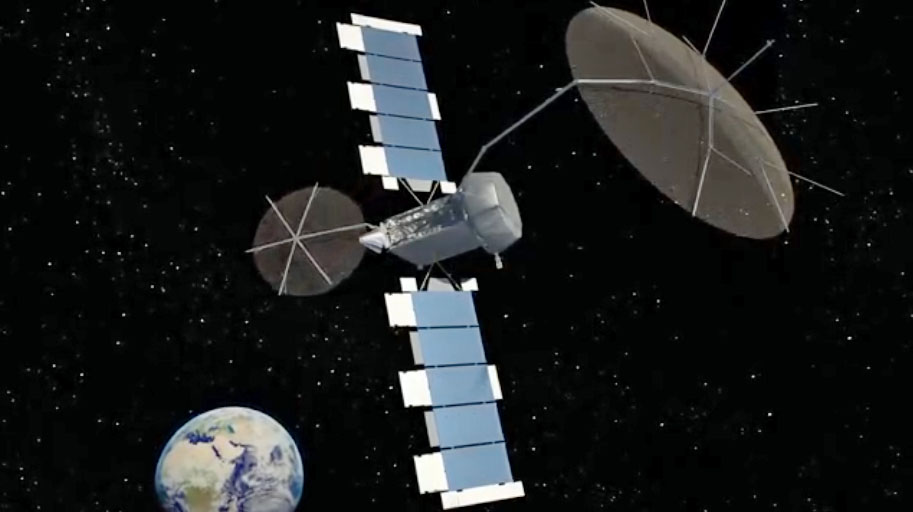
The network will enable secure phone calls, classified data transfers and video on demand by military forces aboard ships, submarines, aircraft and land vehicles, plus terminals in the hands of troops while on the move.
MUOS uses Internet Protocol versions 4 and 6 (IPv4/IPv6) to give the warfighter worldwide roaming connectivity to the Global Information Grid.
“This network access for deployed tactical users will allow the exchange of critical situational awareness and targeting information,” said Navy Commander Peter Sheehy, principal assistant program manager of MUOS.
“As a Naval pilot, MUOS will really bring that expanded communications chain and allow us to coordinate with forward air controllers, those tactical controllers who need air support, at a much greater range. So it will be less time over the target area. We will be able to get there, provide the support and leave.”
This launch comes after engineers traced the first stage performance trouble on the last Atlas launch to a misbehaving fuel mixture control valve. The hardware on the MUOS 5 rocket has been tweaked to prevent a reoccurrence.
The United Launch Alliance vehicle, flying in its most powerful 551 configuration with five solid rocket boosters flanking the first stage, will lift the 15,000-pound payload into a high-perigee geosynchronous transfer orbit.
The 551 rocket variant has flown six times in 10 years, launching NASA’s New Horizons probe in 2006 to Pluto and beyond, the agency’s Juno spacecraft in 2011 that will enter orbit around Jupiter on July 4 and the MUOS fleet.
The Atlas 5 rocket with MUOS 5 aboard stands 206 feet tall and will weigh 1.3 million pounds at launch.

The MUOS constellation is designed to extend narrowband communications services for the U.S. military beyond 2025. The satellites, built by Lockheed Martin in Sunnyvale, California, offer both Ultra High Frequency communications provided via older spacecraft and a new rugged smartphone system for mobile forces.
“The legacy satellite communication system allowed users to ‘talk’ as long as they were within the same satellite footprint,” said Kan. “MUOS allows troops all over the world to talk, text and share mission data seamlessly without having to worry about where they are in relation to a satellite.”
Coverage to legacy users transmit through a 17.7-foot-diameter reflector on the craft and the advanced, multi-beam features of MUOS to significantly increase the transmission capacity over the Navy’s previous satellites will use a large 46-foot reflector on MUOS.
“The legacy payload we have on MUOS satellites allows a smooth transition to a newer, better MUOS capability. We are benefitting from providing the legacy channels for current users and we are exploring all the capability that MUOS has to offer,” said Nina Tran, the Navy program office’s space division director.
As the spare satellite for the constellation, the unique mission for MUOS 5 immediately provides the legacy UHF communications while waiting for a future need to replace one of its sister-craft in the smartphone system.
This MUOS satellite will reside 22,300 miles over the Indian Ocean, alongside MUOS 4.
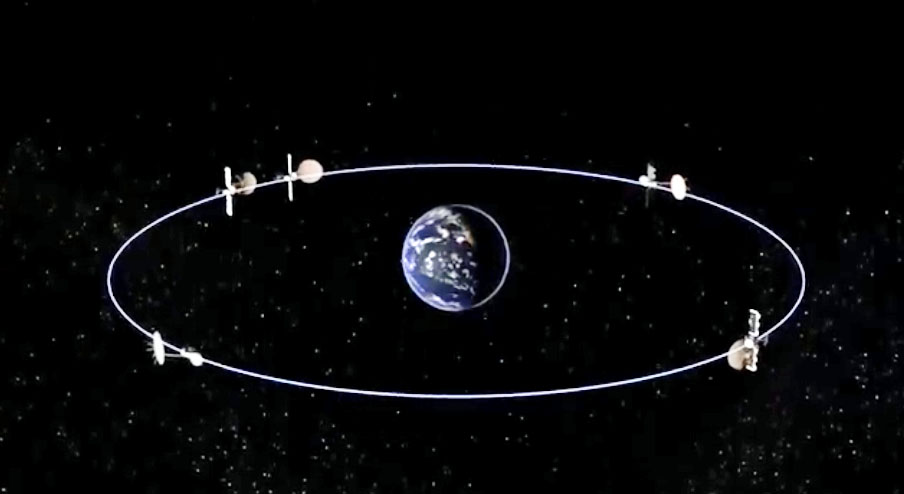
All U.S. military forces rely upon Navy satellites for Ultra High Frequency narrowband communications. UHF offers small, portable units that forces can carry into battle and the frequency enables communications in urban canyons and mountainous terrain, penetrating foliage and transmitting through bad weather.
The MUOS architecture includes the five satellites, four ground stations located in Western Australia, Sicily, Virginia and Hawaii and the complex software to make the system function.
“The nice thing about MUOS is that the ground system and terminals contain all the switching and routing technology,” said Jim Parsons, the Navy program office’s technical director.
“The satellite remains unchanged over time and can allow technology insertion into the ground stations and the waveform over time to increase capability without having to make any satellite changes.”
After the geosynchronous orbit is reached, MUOS 5 will undergo critical deployments of the solar arrays to stretch 94 feet tip-to-tip and unfurling the two gold mesh antennas.
MUOS No. 1 was launched Feb. 24, 2012 aboard an Atlas 5 and serves as the Pacific Ocean satellite. MUOS No. 2 launched July 19, 2013 aboard another Atlas 5 and serves as the continental U.S. satellite. MUOS No. 3 went up atop an Atlas 5 on Jan. 20, 2015 to cover the Atlantic Ocean region. An Atlas 5 launched MUOS No. 4 on Sept. 2, 2015 to serve the Indian Ocean region.
The Navy has completed acceptance testing and activated UHF service aboard the first four MUOS satellites. MUOS 5 should be activated by Christmas.
Deployment of the radios and terminals for the smartphone system will be occurring over the next two years.
Discussions are underway with allied nations — Canada, Australia, the United Kingdom and the Netherlands — about buying into the network to gain access to the whole MUOS system. An additional satellite would be built with international funding to increase the MUOS capacity, if more countries join.
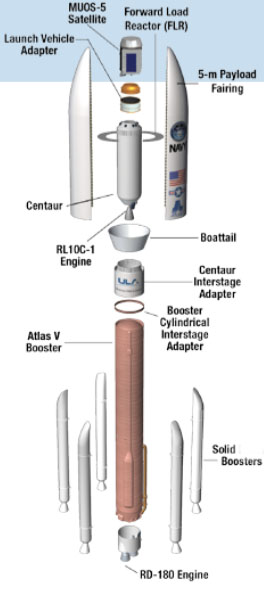
A typical Atlas 5 launch to geosynchronous transfer orbit, the standard dropoff point for communications satellites, uses just two firings by the Centaur to achieve the highly elliptical, egg-shaped orbit to deploy the payloads. From there, the satellites use their own engines in the subsequent days to fly into the operational locations 22,300 miles above the equator.
But the sizable MUOS drove planners to create a three-burn launch profile for the payload to use all of the available performance from the Atlas-Centaur that in turns saves the satellite’s precious onboard fuel supply for maneuvering over its 15-year life.
The three burn mission design for MUOS provides 1,000 pounds greater lift capability than a conventional two-burn geosynchronous transfer orbit.
A preliminary parking orbit almost 400 miles high, tilted 28 degrees to the equator, is achieved just over 12 minutes into the launch as the Centaur shut down the engine and enters a brief cruise across the central Atlantic.
Just off the western coast of Africa, the Centaur main engine then restarts about 20 minutes after launch to propel MUOS to the second step on its way to the planned orbit. This six-minute burn puts the rocket into an elliptical 120 by 21,400 mile orbit inclined 26 degrees.
Then begins a lengthy coast away from the planet for two-and-a-half hours, flying to a point about 17,000 miles above the far eastern Indian Ocean where the final burn occurs.
One last push is given nearly two hours and 49 minutes into flight to raise the orbit’s low point and reduce the inclination closer to the equator. The burn, lasting a minute, places the payload into a high-perigee geosynchronous transfer orbit of 2,387 by 22,187 statute miles at an inclination of 19.10 degrees.
The satellite separates from Centaur some two hours and 54 minutes after liftoff to complete the launch, or 1:24 p.m. EDT (1724 GMT) given an on-time liftoff.

ATLAS/MUOS 5 ASCENT TIMELINE
T-0:00:02.7 Main Engine Start
T+0:00:01.1 Liftoff
T+0:00:49.3 Max Q
T+0:01:48.7 Jettison 1-2 SRBs
T+0:01:50.2 Jettison 3-4-5 SRBs
T+0:03:27.8 Nose Cone Jettison
T+0:03:32.8 Load Deck Jettison
T+0:04:25.6 Main Engine Cutoff
T+0:04:31.6 Stage Separation
T+0:04:41.5 Centaur Ignition 1
T+0:12:28.4 Centaur Cutoff 1
T+0:20:27.6 Centaur Ignition 2
T+0:26:14.5 Centaur Cutoff 2
T+2:48:40.4 Centaur Ignition 3
T+2:49:38.7 Centaur Cutoff 3
T+2:53:17.7 Spacecraft Separation
The Launch Readiness Review is planned for Wednesday, followed by rollout of the rocket to the launch pad on Thursday morning. The countdown sequence Friday morning lasts seven hours to prep the the two-stage vehicle and fuel it with 66,000 gallons of cryogenics.
The MUOS No. 5 launch will be the 63rd Atlas 5 flight and the third of 10 planned this year.
For United Launch Alliance, it’ll mark the 108th flight for the company in 9 years and the fifth of 2016.
See earlier MUOS 5 coverage.
Our Atlas archive.

